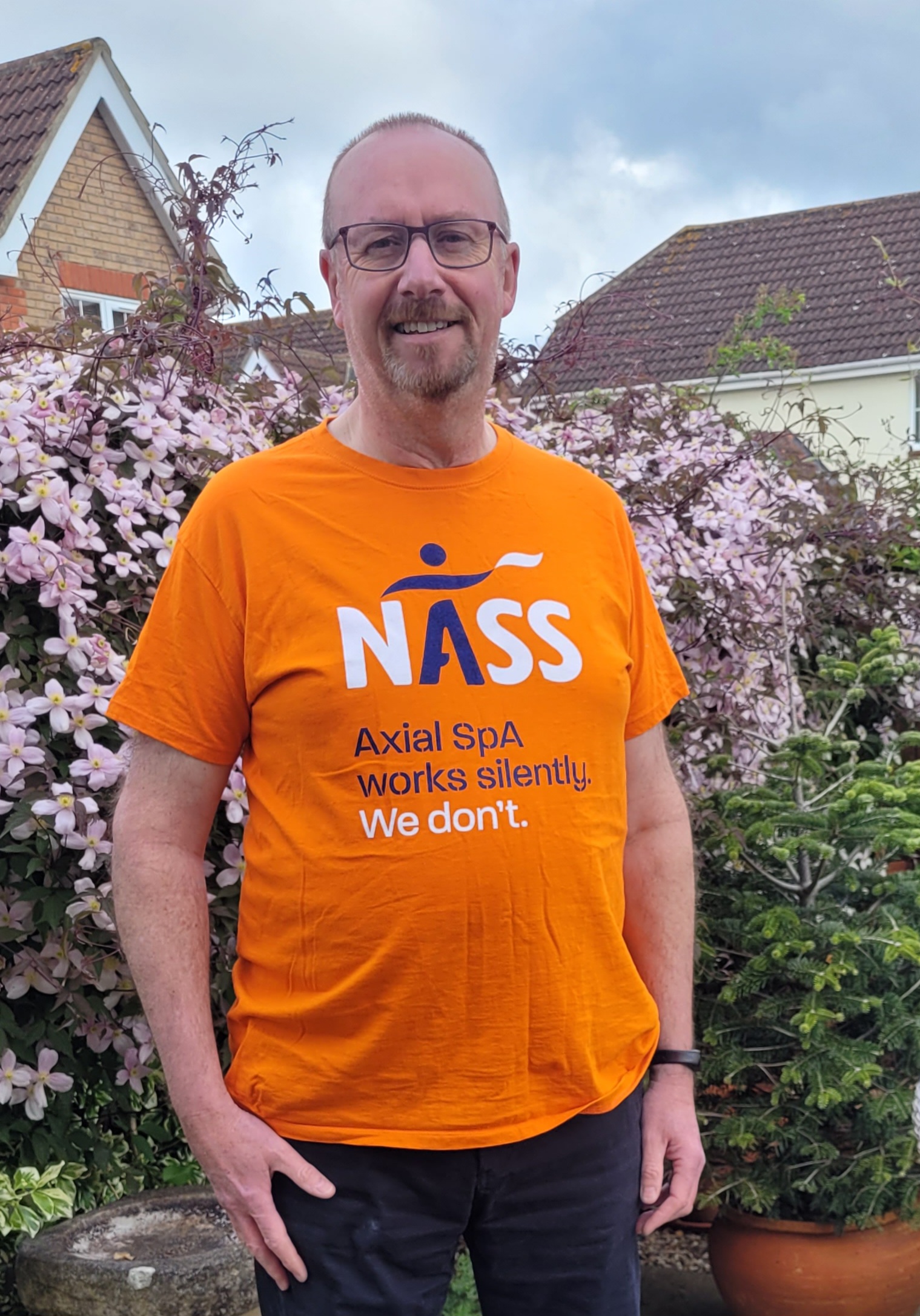“I don’t let axial SpA run or dictate my life. I’ve continued to enjoy trekking in the great outdoors and making the most of the opportunity to be active with the annual Walk Your AS Off step challenge during May.”
Alex’s pain could become so extreme that he could miss his stop on his morning commute because he couldn’t get off his seat. Thankfully, he was diagnosed with axial SpA fairly quickly. Since then, he has become a member of NASS Colchester and really benefitted from their support, as well as the information and support provided by NASS. Last year, he joined Walk Your AS Off to continue enjoying the great outdoors whilst keeping moving.
Here’s his story.

In the mid-1990s, I started to experience increasing amounts of pain in my legs and back on long car journeys and when doing the daily train commute; on more than one occasion I missed my stop on the train when the pain was so intense, I couldn’t get out of my seat.
I was extremely lucky with my diagnosis. When I first moved to Essex, towards the latter part of the 1990s, and signed up with a local GP practice, I spoke to one of doctors about these pains and some of the limitations in movement I was experiencing in my neck and back. They almost immediately said: “I think you have Ankylosing Spondylitis (axial SpA), but we’ll need to do a blood test”. The results came back that I had a gene variant called HLA-B27. It was axial SpA. I was referred to the rheumatology department of the local hospital. The rheumatologist confirmed the diagnosis with an x-ray that revealed the inflammation in my sacroiliac joint.
This early diagnosis, the referral to rheumatology and then access to physiotherapy support was important in helping me to understand and deal with my condition in those early days. There is a lot to take in when you are first diagnosed, and it is hard to fully understand what you are up against.
Currently, on average, it is taking eight and half years to get a diagnosis. This kind of delay is having a real impact on people’s physical and mental well-being, their families, employers, and the economy as a whole – according to NASS, the cost is close to £19bn a year. I’ve experienced first-hand the benefits of an early diagnosis so anything that can be done to address the delays, including more education and training for GPs to recognise the symptoms, is crucial to ensure as early a diagnosis as possible. The earlier you identify the condition, the more that you can do to reduce its impact on your daily life.
It is estimated that 1 in 200 of the UK adult population has the condition, making it more prevalent than ‘well-known’ conditions such as MS and Parkinson’s. It is around three times more common in men than in women – making it something men are better at than women! Yet, axial SpA remains not that well understood or talked about. That’s in part understandable when ‘back pain’ and ‘back problems’ are so prevalent in our society. It can be hard for people to understand the impact of a condition that affects your joints but improves with movement and exercise! That makes building more awareness of axial SpA, its symptoms and the management of the condition vitally important.
I was surprised to learn when I told my boss at work about my diagnosis that not only did he have axial SpA, but one other in the 9-person team had it too. Sadly, we didn’t discuss any aspect of the condition and what we were doing to deal with axial SpA. As I have found, talking to others with axial SpA can have a beneficial effect on your attitude to the condition and how you manage it on a day-to-day basis.
I don’t let axial SpA run or dictate my life. I have been able to walk 100kms along the Great Wall of China, trek down into the base of the Grand Canyon, spend time walking in the Australian outback and completed several trails in New Zealand including the amazing Milford Track. Since retiring at the end of 2021, I’ve continued to enjoy trekking in the great outdoors and making the most of the opportunity to be active with the annual Walk Your AS Off step challenge during May.
A big part of my positive attitude comes from the support I can access via NASS, both at the national and local level. Our weekly sessions at the NASS Colchester group with physios Josh, Chris, Gabby, and Amanda are not just a chance to exercise, I am learning more and sharing more about axial SpA. And we do this all with a smile and a laugh. The group’s mantra, thanks to Josh and usually shouted during a HIIT (High Intensity Interval Training) session, is “Motion is Lotion”. Now you can’t argue with that!
The information available through NASS centrally is excellent. The more you know, the more you understand. The launch of the Your SpAce community and online meet ups provides videos and resources on areas such as dealing with pain, flare ups and fatigue.
This support and information, together with regular exercise and physio sessions, makes a real difference to my day-to-day management of AS. I have been able to accept my axial SpA and not be limited by it.
Feel inspired by Alex’s story?
Click here to find out more about Walk Your AS Off.